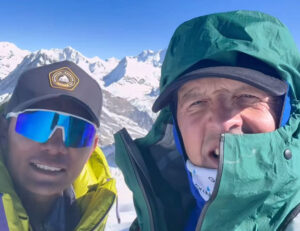Oh, to be a fly on the wall at Manaslu’s Base Camp. While some climbers continue toward the summit, down below the mood is decidedly mixed.
Some have retreated from previous statements. Others stubbornly claim summits that are not. A few assume that they’ll have to climb the mountain again. And a stony silence persists from the agencies that were well aware of both the summit/foresummit controversy and of Mingma G’s intentions to reach the highest point. Still, both before and after Mingma G succeeded, they took their clients to the usual photo point.
This has led to some surreal situations. A number of outfitters keep claiming that they reached the summit, even after their photos show them on an obviously lower point. “Manaslu done, 100% success,” said expedition leaders and guides like Kami Rita Sherpa and Nirmal Purja. Meanwhile, one of Purja’s own team members, Jackson Groves, filmed the group from all angles by drone. The footage proves that they stopped below the final ridge.
A bitter prize
Nepal’s Department of Tourism has duly distributed official summit certificates to all those who reached a foresummit. But this has become a bitter booby prize for some of those recipients.
Shehroze Kashif of Pakistan, for example, had proudly unfurled his country’s flag on his supposed summit. But he faced a major backlash on social media after Groves’ drone footage appeared.
At first, the 19-year-old climber stated on social media that he had reached the highest point that anyone had in autumn since 1976. Then he discovered back in Kathmandu that Mingma G had reached the actual summit. Kashif then decided that it was “his duty and his job, as part of his project to become the youngest 14×8,000m summiter, to return to Nepal and, inshallah, climb Manaslu to the real summit.”

Shehroze Kashif shows his summit certificate, right before announcing that he will return to Manaslu. Photo: Shehroze Kashif/Facebook
The fact is, however, that wherever climbers had chosen to stop in recent decades, others in the past had reached the actual summit. The question now is how many climbers knew that they were stopping short. It is not likely that any in the last five years were unaware of the controversy around Manaslu.
How many knew, and how many just played along?
The hundreds of climbers who had topped out at a foresummit, either guided clients or independent climbers following the fixed ropes to where they ended and no further, were either assured that they were on the summit or had tacitly agreed with the fiction and did not stir the pot. They pocketed their certificates and went home.
This would have continued if a Sherpa guide had not decided to press further, and if drone footage had not powerfully shown that maintaining this convenient hoax just didn’t make sense anymore.
The outfitters are now under scrutiny for their role in the scam. Every climber has a right to stop before the highest point on a mountain for any reason, and still feel his climb has been complete and rewarding. But no climber, no expedition leader, and no outfitter should claim a summit that is not.
The situation has also confused those who were in Base Camp or busy with their own summit pushes, as the drone images spread everywhere. Yesterday, Lukas Furtenbach heard from his team on the mountain, reporting perfect conditions on the “real” summit. Twenty-four hours later, Furtenbach himself contacted ExplorersWeb to amend his previous statement.
Furtenbach corrects
“After analysis with guides and Sherpas, I have to correct: They stood at the last of the foresummits, not the one Mingma G made,” he told ExplorersWeb. Furtenbach apologized for the confusion, which he attributed to bad communication with the summit team.
“It was confusing,” Furtenbach added. “Our guide, Rupert Hauer, climbed several metres further than the end of the ropes and stopped at the next bump.”
He confirmed that his team had not taken the traverse, but tried to follow the summit ridge itself. “The rope Mingma G left and the footprints were not visible at all,” he said. “[This] makes sense, because since the Imagine Nepal team summited on September 28, it has been snowing.”

Rustan Nabiev at a higher camp on Manaslu. Photo: RussianClimb
Furtenbach’s information suggests that no one else reached Manaslu’s true summit yesterday. For Russian double amputee Rustam Nabiev, however, reaching the foresummit is a remarkable triumph. Nabiev lost his legs when the military building in which he served in Omsk collapsed and killed 24 of his colleagues. Miraculously, he survived. Details about his climb will follow in the coming days.
Manaslu was also an added challenge for visually impaired Canadian Jill Wheatley. Still, on September 28, Wheatley properly summited Manaslu with her Imagine Nepal group. She became not just the first visually impaired woman on that summit, but possibly the first Canadian — and one of the first women? There is a lot to research and possibly a lot to change in the history of Manaslu.






